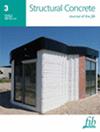内含螺旋钢筋的 GFRP 钢筋混凝土柱的性能
IF 3.3
3区 工程技术
Q2 CONSTRUCTION & BUILDING TECHNOLOGY
引用次数: 0
摘要
本文研究了玻璃纤维增强聚合物(GFRP)加固混凝土柱与集成钢螺旋(混合加固)的行为。在偏心轴向荷载作用下对六根混凝土柱进行了测试,结果表明这些柱子因弯曲而失效。带有外层纵向钢筋的柱子在峰值荷载时出现钢筋屈服,而带有 GFRP 外层钢筋的柱子则因混凝土破碎而失效。结果表明,与使用钢筋的柱子相比,使用 GFRP 作为外纵向钢筋可使峰值荷载降低 3-10%。螺旋钢筋的内部约束提高了承载能力。此外,使用内管钢的柱子比使用螺旋钢的柱子强度更高,这表明限制效果略有增强。考虑到材料和几何非线性因素,开发了一个有限元模型来分析结构行为。通过将预测结果与测试结果进行比较,验证了模型的准确性。非线性有限元模型的参数分析表明,偏心对支柱的承载能力有显著影响。增加内部约束面积和内部纵向杆件数量可提高结构刚度和承载能力。此外,还提出了一种简化的理论方法。对比实验破坏荷载和理论预测值发现,两者之间的差异在 20% 以内,这表明所提方法的可靠性令人满意。本文章由计算机程序翻译,如有差异,请以英文原文为准。
Behavior of GFRP reinforced concrete columns confined with inner steel spirals
The paper investigates the behavior of glass‐fiber reinforced polymer (GFRP) reinforced concrete columns with integrated steel spirals (hybrid reinforcement). Six concrete columns were tested under eccentric axial loading, resulting in failure due to bending. Columns with outer steel longitudinal bars experienced steel yielding at peak loads, while those with GFRP outer rebars failed due to concrete crushing. The results revealed that using GFRP as outer longitudinal bars led to peak loads 3–10% lower compared to columns with steel rebars. Inner confinement by steel spirals increased the load‐carrying capacity. Additionally, columns with inner tubular steel exhibited greater strength than those with steel spirals, indicating a slightly enhanced confinement effect. A finite element model was developed to analyze structural behavior, considering both material and geometric nonlinearity. The model's accuracy was validated by comparing predictions with test results. Parametric analysis from the nonlinear FE model showed that eccentricity significantly impacted column load‐carrying capacity. Increasing inner confinement area and the number of inner longitudinal bars improved structural stiffness and load‐carrying capacity. Furthermore, a simplified theoretical method was proposed. Comparison between experimental failure loads and theoretical predictions revealed differences within 20%, indicating satisfactory reliability of the proposed method.
求助全文
通过发布文献求助,成功后即可免费获取论文全文。
去求助
来源期刊

Structural Concrete
CONSTRUCTION & BUILDING TECHNOLOGY-ENGINEERING, CIVIL
CiteScore
5.60
自引率
15.60%
发文量
284
审稿时长
3 months
期刊介绍:
Structural Concrete, the official journal of the fib, provides conceptual and procedural guidance in the field of concrete construction, and features peer-reviewed papers, keynote research and industry news covering all aspects of the design, construction, performance in service and demolition of concrete structures.
Main topics:
design, construction, performance in service, conservation (assessment, maintenance, strengthening) and demolition of concrete structures
research about the behaviour of concrete structures
development of design methods
fib Model Code
sustainability of concrete structures.
 求助内容:
求助内容: 应助结果提醒方式:
应助结果提醒方式:


